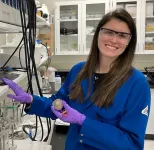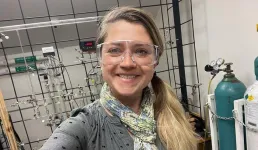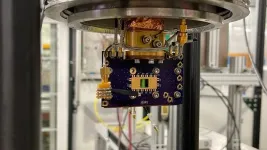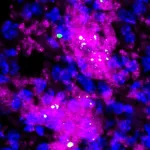(Press-News.org) WASHINGTON, D.C. – An alternative energy mechanical engineer, two aerospace engineers, and a corrosion research engineer received the highest honor bestowed to early career U.S. government scientists and engineers.
These four U.S. Naval Research Laboratory (NRL) researchers each received a Presidential Early Career Award for Scientists and Engineers (PECASE) for their research on next generation energy storage solutions, solid fuel combustion for use in high-speed propulsion devices, solving large-scale chemically reacting flow problems, and the many ways corrosion directly impacts Navy assets.
A White House press release announced the winners for 2024 on Jan. 14. The awards were established by President Clinton in 1996, to recognize scientists and engineers who show exceptional potential for leadership early in their research careers.
The award recognizes innovative and far-reaching developments in science and technology, expands awareness of careers in science and engineering, recognizes the scientific missions of participating agencies, enhances connections between research and impacts on society, and highlights the importance of science and technology for our nation’s future.
“We at NRL are very proud of the awardees,” said NRL Chemistry Division Superintendent Dr. John Russell. “Their research accomplishments are being recognized for their significant contributions to science in support of the missions of the U.S. Navy and Marine Corps. The awardees are representative of the quality of the workforce and research program at NRL.”
NRL’s newest PECASE recipients include:
Rachel Carter, Ph.D., an NRL Alternative Energy Section mechanical engineer, focuses on incorporating safer and more globally abundant materials in next generation energy storage solutions.
These efforts address the growing civilian and Department of Defense (DOD) needs for high energy density portable energy storage to support advanced technology including autonomous systems and electrified transportation.
“I am incredibly humbled to be recognized among the nearly 400 scientists honored by the President for addressing the need to develop a domestic supply chain of battery materials and manufacturing,” said Carter.
Carter focuses on sodium and sulfur, which produce a high energy discharge reaction, e.g. theoretically 10X Li-ion, and are abundantly distributed among the Earth’s crust and in abundance in North America. These batteries are not commercially available due to the complexity of their reaction.
“This recognition fuels me to continue upping my game and delivering the best quality and most impactful research that I can,” Carter said. “I could not have received this award without the contributions of my incredibly talented collaborators at NRL and the support system provided to me here, particularly from my postdoctoral advisor, Dr. Corey Love, who has supported my wild ideas and personal growth. I must also acknowledge my family who normalized my interest in building things as a young girl and supported my pursuit of an advanced science degree and career in government research.”
Carter’s research centers around providing resiliency to the Navy and DOD with higher energy batteries produced with a healthy domestic supply chain.
Since joining NRL as a Post-Doctoral Researcher in the summer of 2017, Carter continues to build interdisciplinary collaborations across the lab to understand and facilitate these reactions in new and impactful ways. “Through this research, we have identified inherit benefits of sodium behaviors compared to lithium, designed novel sulfur cathodes, and optimized the liquid electrolyte formulation,” Carter said.
Brian T. Bojko, Ph.D., an NRL Laboratories for Computational Physics and Fluid Dynamics (LCP&FD) aerospace engineer, conducts high-impact research regarding the investigation of solid fuel combustion for use in high-speed propulsion devices.
He is a leading researcher in computational combustion, specializing in the modeling of complex reacting flows with applications in energetics, propulsion, and munition safety.
Bojko began his career as a civilian researcher for the U.S. Navy at the Naval Air Warfare Center Weapons Division (NAWCWD) at China Lake, where he carried out groundbreaking research on the combustion of solid rocket fuels and their components. He applied this research to large-scale simulations of propulsion systems and helped optimize the design of rocket engines. During this time, he also earned the Munitions Safety Information Analysis Center (MSIAC) Award for Technical Achievement, recognizing his significant contributions to munition safety and technology innovation.
After four years at NAWCWD, Bojko took a position at LCP&FD at NRL where he continues to advance computational fluid dynamics and multiphase combustion. As a principal investigator, he leads projects on the combustion of solid fuels, reduced-order computational methods for reacting flows, and metallized reacting flows. He has published over 40 journal articles and conference papers and has earned multiple accolades, including the American Institute of Aeronautics and Astronautics (AIAA) Propellants & Combustion’s Best Paper Award and two Alan Berman Research Publication Awards. In addition to his research, Bojko plays a key leadership role in the combustion and propulsion communities, serving as chair of the Air-Breathing Propulsion Ramjet Subcommittee for the Joint Army-Navy-NASA-Air Force (JANNAF) Interagency Propulsion Committee and for the Propellants and Combustion Technical Committee for AIAA.
“I am extremely honored to have received the PECASE, especially with other very talented researchers as I could not have achieved this on my own and am very grateful to all my collaborators and leadership for their support throughout the years,” said Bojko. “My research has had a direct impact on DOD programs of record, including ongoing research and design efforts for hypersonic flight vehicles. I look forward to exploring more challenging problems and continuing the meaningful work we do here at NRL.”
As the operational threats posed to the United States evolve in the era of hypersonic weapons, it has become increasingly urgent for the Navy and DOD to develop and field a variety of tactical systems and countermeasures to maintain battlespace superiority. The work Bojko conducts explicitly addresses these needs.
Ryan F. Johnson, Ph.D., an NRL LCP&FD aerospace engineer, specializes in developing solutions to solve large-scale chemically reacting flow problems that impact a range of critical defense applications, including propulsion, power generation, and high-speed nonequilibrium aerodynamic flows.
These contributions will enable the design of more robust and efficient engines for both propulsion and power-generation applications and help understand and predict the loading and environment experienced during hypersonic flight to empower design and optimization of emerging vehicles.
“This is such a great honor, but I want to emphasize that my work has always been, and continues to be, a collaborative effort with many exceptional scientists and engineers,” said Johnson. “This recognition reflects the support and belief of devoted management who have lifted myself and colleagues up and provided these opportunities. Dr. David Mott, who nominated both Dr. Bojko and I, sadly passed away before he could fully celebrate this moment with us. I wish he were here to share in this milestone. The hillside son from a place with more cows than people – I never could have imagined receiving an award signed by the President.”
Johnson’s work is integral to NRL’s ability to predict and understand chemically reacting flow in harsh, high-speed environments. He works on essential stability tools for high-fidelity simulations of chemically reacting flows and has co-developed seminal work in structure-preserving methods, a focus he continues to actively pursue. These contributions have been invaluable for several of NRL’s high-speed propulsion projects, including several hypersonics-related projects that rely on this capability.
He was also an integral part of a team receiving competitive, internally reviewed funds for a large program focused on understanding the impacts of weather on hypersonic flight. In addition, he was an essential member of NRL’s first collaborative team built to understand the fundamentals of solid fuel combustion and the fuel’s response to chemical additives; this team continues to work in this area and is expanding the portfolio to include experts throughout the Navy, DOD, and Department of Energy.
Johnson continues to create and validate computational capabilities enabling the high-fidelity simulation of chemically reacting flows, while applying these capabilities to address critical Navy challenges in propulsion and hypersonics.
Mary E. Parker, Ph.D., an NRL Center for Corrosion Science and Engineering materials research engineer, specializes in advanced materials, galvanic compatibility, and the many ways corrosion directly impacts Navy asset design, availability, and sustainability.
Naval platforms operate in a harsh marine environment that constantly threatens the sustainability of Naval assets and the safety of Sailors and Marines.
Corrosion is a nationwide and worldwide challenge and impacts all classes of engineering materials and systems, particularly both public and private infrastructure, oil and gas platforms and piping, commercial ships, power production plants and the chemical production industry. In the marine environment, naturally occurring salts present in seawater create highly corrosive conditions for metallic materials.
“I chose a career in materials science and electrochemistry because I love understanding the ‘why’ behind material behavior,” said Parker. “In my time at NRL, I have had the privilege of applying my interest in science and engineering to solve impactful problems for the Navy. It is such an honor to receive a PECASE award.”
Parker was a critical member of a team that conducted the most substantial assessment of marine corrosion alloy behavior since the 1980s. She analyzed 33 alloys over multi-year experiments to address longstanding technical gaps in corrosion science, material performance and material compatibility. Notably, she assessed the impact of cathodic ennoblement on crevice corrosion initiation in many highly alloyed corrosion resistant materials. Her findings were in direct contrast to conventionally assumed immunity for these alloys in seawater.
Parker added she is grateful to the advisors and mentors who have supported her throughout her career and helped her become the best researcher she can be. Parker hopes to pass that same gift on to the young scientists and engineers she mentors.
“It is extremely rewarding to see my work have a meaningful impact on the Fleet,” Parker said. “One of the best things about leading applied research efforts is seeing ideas that began as laboratory scale theories become successful out in the real world. As someone who identifies as both a scientist and an engineer, I love being the bridge between the research lab and full-scale applications.”
In her work on galvanic compatibility of marine materials, she provided the foundational data used to quantify material interactions as well as design guidance to prevent deleterious effects. These data have since been called upon by several naval ship construction programs to evaluate designs and provide the basis for specification requirements for future designs of Navy ships.
Parker remains motivated because she knows that it makes a difference in the lives of the Sailors and Marines who work and live on Naval platforms every day.
About the U.S. Naval Research Laboratory
NRL is a scientific and engineering command dedicated to research that drives innovative advances for the U.S. Navy and Marine Corps from the seafloor to space and in the information domain. NRL is located in Washington, D.C. with major field sites in Stennis Space Center, Mississippi; Key West, Florida; Monterey, California, and employs approximately 3,000 civilian scientists, engineers and support personnel.
For more information, contact NRL Corporate Communications at (202) 480-3746 or nrlpao@us.navy.mil. Please reference package number at top of press release.
END
Presidential awards spotlight naval research excellence
2025-02-11
ELSE PRESS RELEASES FROM THIS DATE:
SETI Institute names first Frank Drake Postdoctoral Fellow
2025-02-11
February 11, 2025, Mountain View, CA -- The SETI Institute awarded the first Frank Drake Postdoctoral Fellowship to Dr. Anastasia Yanchilina. Yanchilina will focus on distinguishing biosignatures from false positives across space and time. Her research combines experimental and analytical research to refine biosignature detection techniques. She will conduct lab experiments to generate key mineral analogs and study Earth’s extreme environments to understand what potential signs of life to look for on other planets.
“It has long been my scientific dream to explore whether life exists ...
From photons to protons: Argonne team makes breakthrough in high-energy particle detection
2025-02-11
Particle detectors play a crucial role in our understanding of the fundamental building blocks of the universe. They allow scientists to study the behavior and properties of the particles produced in high-energy collisions. Such particles are boosted to near the speed of light in large accelerators and then smashed into targets or other particles where they are then analyzed with detectors. Traditional detectors, however, lack the needed sensitivity and precision for certain types of research.
Researchers at the U.S. Department of ...
Cancer’s ripple effect may promote blood clot formation in the lungs
2025-02-11
Blood clots form in response to signals from the lungs of cancer patients—not from other organ sites, as previously thought—according to a preclinical study by Weill Cornell Medicine, Memorial Sloan Kettering Cancer Center and University of California San Diego Health. Clots are the second-leading cause of death among cancer patients with advanced disease or aggressive tumors.
While blood clots usually form to stop a wound from bleeding, cancer patients can form clots without injury, plugging up vessels and cutting off circulation to organs. The study, published Feb. 11 in Cell, shows that tumors drive clot formation (thrombosis) by releasing ...
New UVA clinical trial explores AI-powered insulin delivery for better diabetes care
2025-02-11
For people living with Type 1 Diabetes (T1D), keeping blood sugar levels in check is a constant challenge. A new clinical trial at UVA is aiming to simplify diabetes management by testing an innovative AI-powered device designed to improve automated insulin delivery.
The trial is co-led by several School of Data Science faculty, including Assistant Professor of Data Science Heman Shakeri; Boris Kovatchev, founding director of the UVA Center for Diabetes Technology, a professor at the School of Medicine and professor ...
New technology could quash QR code phishing attacks
2025-02-11
The ubiquitous QR (“quick response”) codes that appear on everything from parking pay stations to soda cans and promotional flyers have become an increasingly popular target for cybercriminals to exploit through QR code–based phishing attacks, also known as “quishing.” Bad actors will place phony QR codes that direct smartphone users to enter their sensitive private information in fake websites masquerading as bank websites, parking enforcement offices, or other seemingly ...
Study reveals direct gut-brain communication via vagus nerve
2025-02-11
A new study in an animal model provides direct evidence for the role of the vagus nerve in gut microbiome-brain communication, addressing a critical gap in the field.
The research, led by Kelly G. Jameson while a PhD student in the Hsiao Lab at UCLA, demonstrates a clear causal relationship between gut microbiota and vagal nerve activity.
While the vagus nerve has long been thought to facilitate communication between the gut microbiome—the community of microorganisms living in the intestines—and the brain, direct evidence for this process ...
MSU expert: Using light to hear biology
2025-02-11
Images
Elad Harel is used to shining a light on the mysteries of the natural world.
Working at the cutting-edge of ultrafast spectroscopy — the application of short laser pulses to analyze the dynamics of molecules — the Michigan State University associate professor’s research aims to reveal how microscopic phenomena impact large complex systems.
One promising frontier Harel has been working on is the development of new methods of microscopy that will allow researchers to observe molecular and atomic landscapes in motion rather than through static imagery. Such work has earned Harel MSU’s 2023 ...
“I can’t hear you, I’m too stressed”: Repeated stress in mice reduces sound perception
2025-02-11
After a week of stress, mice show changes in how their brains process sound, reducing how well they perceive loud noises, according to a study published February 11th in the open-access journal PLOS Biology led by Ghattas Bisharat, from the Ben-Gurion University of the Negev in Israel, and colleagues.
Repeated stress has negative impacts on mental health that can go beyond psychiatric disorders. They can also cause changes in how we perceive the world, making us jump at loud noises, or become easily irritated by scratchy sweaters or offensive odors. To understand how repeated stress can impact how the brain processes sensory information, the authors ...
Chronic stress affects how brain processes sound in mice
2025-02-11
BEER-SHEVA, Israel, February 11, 2025 – Chronic stress changes the way our brain processes sounds, according to new research conducted on mice at Ben-Gurion University of the Negev. For instance, sounds need to be louder during chronic stress to trigger similar responses.
Chronic stress is known to impact learning and decision-making, but could it also affect how we hear? Dr. Jennifer Resnik from Ben-Gurion University’s Department of Life Sciences set out to find whether stress influences basic brain functions, ...
Insilico Medicine announces developmental candidate benchmarks and timelines for novel therapeutics discovered using generative AI
2025-02-11
Cambridge, MA – Insilico Medicine ( “Insilico”) , a clinical stage generative artificial intelligence (AI)-driven biotechnology company today announced a set of preclinical drug discovery benchmarks from the 22 developmental candidate nominations achieved by its platform from 2021 to 2024. These benchmarks underscore the platform's efficiency and represent a potential new standard for the drug discovery industry by significantly reducing developmental times, cost, and by allowing resources to be redirected toward further ...








